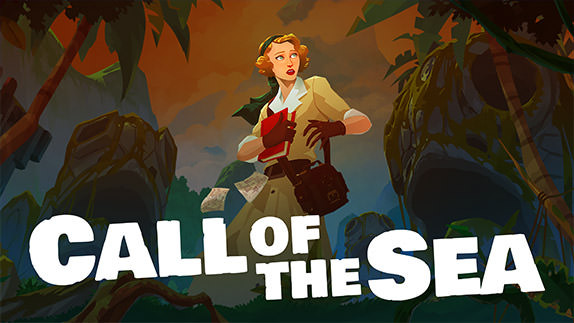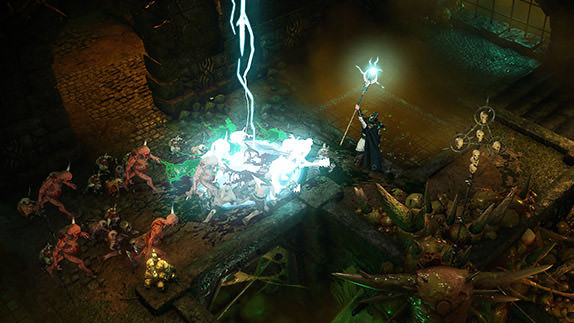We Happy Few Review

 By Kevin Mitchell | Posted: August 15, 2018
By Kevin Mitchell | Posted: August 15, 2018
Back in 2016, Compulsion Games showcased the first five minutes of gameplay for We Happy Few, featuring a highly cinematic narrative focus and a subsequent tense chase sequence. Backed by over 7,000 people on Kickstarter, the initial alpha release of the game was met with harsh criticism, as it focused heavily on survival mechanics and procedurally generated environmental design. Since then, the development team grew in size along with Gearbox Publishing backing the once indie title. More recently, Microsoft purchased the studio; however, We Happy Few remains available across multiple platforms (Xbox One, PC, and PlayStation 4).
One reason for the game's popularity at industry events was its lively stylized caricatures and colorful environments. Pop a Joy, a required hallucinogenic "happy" drug, and stroll along the rainbow-colored streets without a care in the world (just avoid overdosing). The game takes place in an alternate 1960s timeline across a set of islands in the United Kingdom. Each island represents a different "holm" or island in a river. After surrendering to the German army in the 40's (an alternate outcome of World War II), all children under the age of 13 were packed onto trains and taken by the invaders under the threat of further destruction and fear of an army saturated with heavily armored tanks. Joy was developed to help establish a utopian society, where one can forget the terrible things they have done in the past and view the world through rose-tinted glasses.
We Happy Few features three different playable characters, each having their own particular set of skills and expertise, as well as tragic backstory and reasons to escape from Wellington Wells. Arthur Hastings, whom you control first, serves as a redactor, censoring news articles that may stir up feelings from the past or disrupt the flow of society. When he comes across a photograph of his brother, you are presented with the choice of taking your medication or becoming a downer—anyone who refuses to take their Joy. Those who don't become isolated from society and risk being beaten to death by the local bobbies (police officers) that patrol the streets and random citizens wearing white masks hiding their appearance. Outside of being proficient with melee weapons such as metal pipes, rifles, shovels, and even an umbrella, Arthur can quickly run away from danger to compose himself or conceal his position. Each island requires you to conform to its style; otherwise, you risk irritating the locals, who will eventually attack you on sight. Who would have guessed that a kinky rubber cat outfit wouldn't be suitable when strolling through the town center?
Sally Boyle serves as the second protagonist, whom you meet while playing through Arthur's story, with Ollie Starkey acting as the final and third playable protagonist, whom you also interact with through Arthur's narrative. Arthur's portion comprises the highest percentage of the game, which could take anywhere from 10-15 hours to complete, depending on whether you spend time completing side quests. Both Sally's and Ollie's stories are much shorter, but if you wish to see everything the story mode in We Happy Few has to offer, you can easily spend 20-30 hours with the game. Considering all town layouts and streets are procedurally generated, my experience may not match exactly your own. One point, in particular, took much longer to reach than expected, mostly due to the town having only a single path to the objective that required traveling a long way without being seen. By the game's end, you'll feel highly invested in each character's struggles.
I was unprepared for the sheer amount of stealth-focused sequences in We Happy Few. Almost all encounters with Arthur try to guide you through a path of being an unseen menace: choking out individuals from behind, tossing bottles for distractions, etc. If discovered, the game's lacking combat system can't keep up with multiple foes attacking simultaneously. Any time I was seen and had to deal with four or more enemies, it was almost certain I would be reloading from my previous save point unless I got really lucky. The mechanics feel like a cross between BioShock and Dishonored, but not as smooth or polished. Attacks can be strung together to form combos, but the key to survival is blocking and shoving. Blocking is an obvious choice to avoid getting hit, but pushing enemies allows you to break through their block—be warned, enemies will try to do the same to you. Occasionally you'll come across ranged attacks, such as bombs or rocks, which are frustrating to deal with. Even if a grenade hits both you and another enemy nearby, the friendly fire damage is minimal, yet you'll most likely require bandages to stop yourself from bleeding out.
Instead of removing the criticized survival mechanics from earlier builds, they have been toned down, at least in the default settings. Arthur must quench both his hunger and thirst or risk being debuffed or penalized, decreasing the amount of stamina available and making combat much harder to manage. Rotten food can help stop you from going hungry, but be sure you have medication to treat any illness suffered from eating the disgusting, nasty food. The hard difficulty setting severely limits your combat potential; however, you cannot die directly from these mechanics. You'll also have to manage your sleep and Joy intake to avoid overdosing. The other two characters each have their own requirements, and Ollie's, in particular, I found most amusing. Trying to manage his medication shots, while frustrating, was hilarious as he shouted at random individuals, inciting violence. On the normal difficulty, I found each of the mechanics quite enjoyable, and the game features a custom difficulty setting that lets you customize any of these options to your liking.
With their own set of skills to unlock as you progress through the game, each character has unique abilities but also shares many with the other characters. Depending on your play style, you may opt to improve your stealth skills or direct combat-focused options. Other skills can increase your maximum health or the number of items you can carry—both of which were highly important during my playthrough. I can't help myself; with crafting so deeply ingrained into the experience, I went around picking up every scrap of cloth and bits of metal I could scavenge. With these, I was able to craft new weapons, healing balms, bandages, outfits, and more. Most weapons, at least early on, will break after using them for a set amount of time; however, once you craft indestructible items or use the pre-order umbrella, you will probably never need another weapon. Not only does this save time, but it also frees up your weight capacity for additional crafting components.
We Happy Few isn't without technical issues that pop up throughout your experience, at least at launch. While I haven't encountered anything game-breaking, it was common to see items or even other characters floating above the ground or clipping through pieces of the environment. Patrolling AI tend to run into (or through) each other and transition from a slow walk to full sprint for seemingly no reason. The most significant offense is the flashback sequences that provide valuable insight into Arthur's past. These monotone events of the past are quite unstable, making it hard to figure out what is happening when the screen constantly freezes or stutters. The frame rate, even on an Xbox One X, takes a nosedive at times, both in open environments and in tight corridors, with or without other characters on-screen. On the plus side, the voice acting and script are phenomenal.
Simply Put
We Happy Few combines survival mechanics with a deep and thoroughly enjoyable narrative, but technical hiccups hamper the experience. There's a bit too much reliance on stealth, giving a one-dimensional gameplay sensation, but thankfully you don't have to conform to that approach (although things are harder if you don't). Side missions help give life to the charming and witty characters you'll come across but are entirely optional if you want to focus on the main narrative. The technical shortcomings and terrible frame rate are disappointing, along with some annoying missions, but with a deep and thrilling story, I was able to look past some of the glaring issues, as none that I encountered were game-breaking. It's just a shame that Compulsion Games didn't remove the boring open-world sequences and focus further on tightening up the narrative experience.
Note: We Happy Few was reviewed on Xbox One. A digital copy of the game was provided by the publisher/developer.




